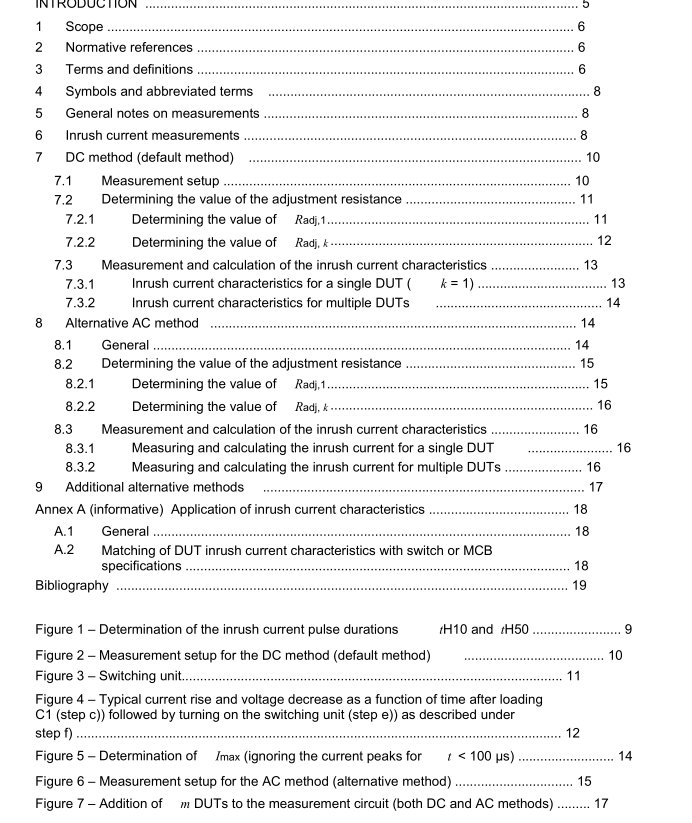IEC 63129 pdf – Determination of inrush current characteristics of lighting products

IEC 63129 pdf – Determination of inrush current characteristics of lighting products
This document describes a method, based on measurements combined with calculations,todetermine specific characteristics of the inrush current of single and/or multiple lighting products
of the same type. Lighting products include the following:
– light sources with integrated controlgear,
-controlgear,
-luminaires.
The inrush current characteristics that are determined are. the peak inrush current,
– the inrush current pulse duration.
This document applies to lighting products connected to low-voltage 230 VAC 50/60 Hzelectrical supply networks.
NOTElIn Clause 6 it is stated that the methodology applies reference values for the reference (line) inductance andthe reference (short circuit) peak current which reflect the typical situation in a 230 V AC installation.
2Normative references
There are no normative references in this document.
3 Terms and definitions
For the purposes of this document, the following terms and definitions apply.
lISO and lIEC maintain terminological databases for use in standardization at the followingaddresses:
.IEC Electropedia: available at http://www.electropedia.orgl
. lso Online browsing platform: available at http:/www.iso.orglobp
3.1
bidirectional diode thyristorDIAC
two-terminal thyristor having substantially the same switching behaviour in the first and thirdquadrants of the current-voltage characteristic
[SOURCE: IEC 60050-521:2002,521-04-66]
3.2
bidirectional triode thyristorTRIAc
three-terminal thyristor having substantially the same switching behaviour in the first and thirdquadrants of the current-voltage characteristic
[SoURCE: IEC 60050-521:2002,521-04-67]
3.3
circuit-breaker
mechanical switching device, capable of making, carrying and breaking currents under normalcircuit conditions and also making, carrying for a specified duration and breaking currents underspecified abnormal circuit conditions such as those of short circuit
[SOURCE: IEC 60050-441:2000,441-14-20]
3.4
control gearcontrolgear
rated current, and which can consist of one or more separate components
Note 1 to entry: The control gear can include means for igniting,dimming,correcting the power factor andsuppressingradio interference, and further control functions.
Note 2 to entry: The control gear consists of a power supply (IEV 151-13-76) and a control unit.Note 3 to entry: The control gear can be partly or totally integrated in the light source.
Note 4 to entry: The terms “control gear”and “controlgear”are interchangeable. In lEC standards,the term”controlgear- is commonlyused.
[SOURCE: IEC 60050-845:—,845-28-048]
3.5
Iinrush
inrush current
transient current associated with energizing of electrical apparatus or components
EXAMPLE Lighting products,transformers, cables,reactors.
[SOURCE: IEC 60050-448:1995,448-11-30, modified – ln the definition, “electrical apparatusor components” replaces “transformer, cables, reactors, etc.” now given as examples.]
3.6
tHx
inrush current pulse duration
time period over which the value of the inrush current is larger than x % of the peak inrushcurrent
Note 1 to entry:See also Figure 1.
Note 2 to entry: Any RF noise should be disregarded.
Note 3 to entry: By this definition, the inrush current pulse duration H50 is the full width at half maximum (FWHM)of the current pulse.
Note 4 to entry: ln this document values of x = 10 and x = 50 are used.3.7
lpeak
peak inrush current
maximum of the absolute value of the inrush current
5 General notes on measurements In this document the term DUT (device under test) is used for the lighting product for which the inrush current characteristics are determined according to the requirements of this document. Controlgear shall be operated at maximum power (100 % light output) and with actual loads or dummy loads as specified by the manufacturer. 6 Inrush current measurements For the measurements, a reference (line) inductance of L ref = 100 µH and a reference (short circuit) peak current I ref = 400 A are used that reflect the average situation in 230 V installations.
The values are based on tests conducted by switch manufacturers that suggest that they represent an appropriate average value. When a different mains voltage is used, the reference line inductance value and the reference peak current value may need to be adjusted. Inrush current measurements could be done with one DUT and the result multiplied by the number of devices in the installation considered. However, this does not reflect the situation in installations as they can be typically found. When different devices are connected in different parts of the circuit, the characteristics of the inrush current as well as the resulting voltage drop in the line are different. Therefore, the reference values defined above are used to simulate the average situation. Measuring a number of k individual DUTs in one measurement setup is equivalent to using one DUT while adjusting the impedance by a factor of k. Therefore, in particular the latter approach – which is the default approach followed in this document – results in a characterization of the inrush current of k DUTs connected to the same network.









